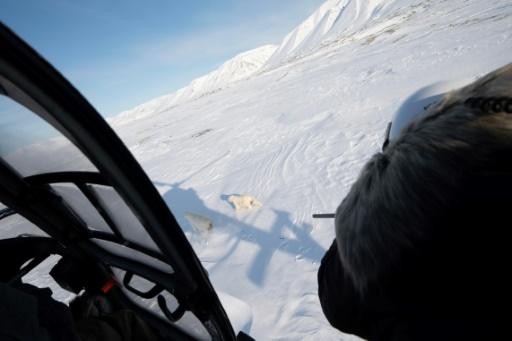
For the past four decades, experts from the Norwegian Polar Institute (NPI) have meticulously monitored the health and movements of polar bears in the Svalbard archipelago, a remote region halfway between Norway and the North Pole. This research is critical as global warming accelerates in the Arctic, occurring three to four times faster than in other parts of the world.
In a daring and risky endeavor, scientists engage in the intricate process of sedating polar bears from helicopters to collect vital data. This year, the team aboard the Norwegian icebreaker Kronprins Haakon is pioneering new methods to study these majestic creatures, including tracking PFAS “forever chemicals” that travel from distant regions and accumulate in their bodies. An AFP photographer captured the dramatic moments of this year’s expedition.
Delicate Surgery on the Ice
Veterinarian Rolf Arne Olberg, with precision and caution, uses a rifle to sedate polar bears from a helicopter. The process involves hitting the bear with a dart, ensuring it lands in a muscle to prevent premature awakening. Olberg explains, “We fly in quickly and try to minimize the time we come in close to the bear… so we chase it as little as possible.”
Once the bear is safely sedated, the team lands to perform a series of tasks. They fit a GPS collar around the bear’s neck, replacing the battery if necessary. Only females are tracked this way because male polar bears have necks too thick to retain the collars. Olberg then carefully inserts a heart monitor to record the bear’s body temperature and heart rate year-round, providing insights into their energy use as their environment changes.
Tracking Dietary Changes
The data collected reveals significant shifts in the diet of Svalbard’s polar bears as ice retreats. Jon Aars, the lead scientist of the NPI’s polar bear program, notes, “They still hunt seals, but they also take eggs and reindeer — they even eat (sea)grass and things like that, even though it provides them with no energy.”
Seals remain the primary food source, essential for the bears’ survival. “Even if they only have three months to hunt, they can obtain about 70 percent of what they need for the entire year during that period,” Aars explains. However, he warns that further warming could threaten their ability to hunt seals effectively, potentially leading to struggles in the future.
Success of Anti-Pollution Laws
Encouragingly, there are signs that pollution levels are decreasing, thanks to stringent regulations. Finnish ecotoxicologist Heli Routti, who has been involved in the program for 15 years, observes, “With some bears that we have recaptured sometimes six or eight times over the years, we have observed a decrease in pollutant levels.”
“The concentration of many pollutants that have been regulated decreased over the past 40 years in Arctic waters,” Routti said. “But the variety of pollutants has increased. We are now observing more types of chemical substances in the bears’ blood and fatty tissues.”
These nearly indestructible PFAS or “forever chemicals,” found in everyday products like cosmetics and nonstick pans, accumulate in the environment and ultimately in the bodies of polar bears and humans. Experts express concern over their potential toxic effects and links to cancer.
Adapting to a Changing Environment
Despite the challenges, polar bears exhibit remarkable adaptability. NPI researcher Marie-Anne Blanchet highlights their resilience, stating, “The bears have another advantage; they live for a long time, learning from experience all their life. That gives a certain capacity to adapt.”
The ongoing research by the NPI not only contributes to our understanding of polar bears but also informs global environmental policies. The data supports the Arctic Monitoring and Assessment Program (AMAP), influencing regulations and bans on harmful pollutants.
As the Arctic continues to warm, the work of these scientists becomes ever more crucial. Their findings underscore the importance of continued monitoring and adaptation strategies to ensure the survival of polar bears in a rapidly changing world.







